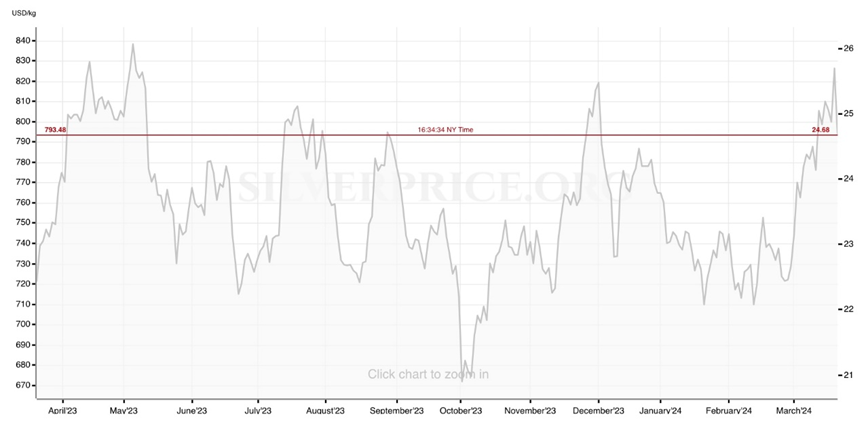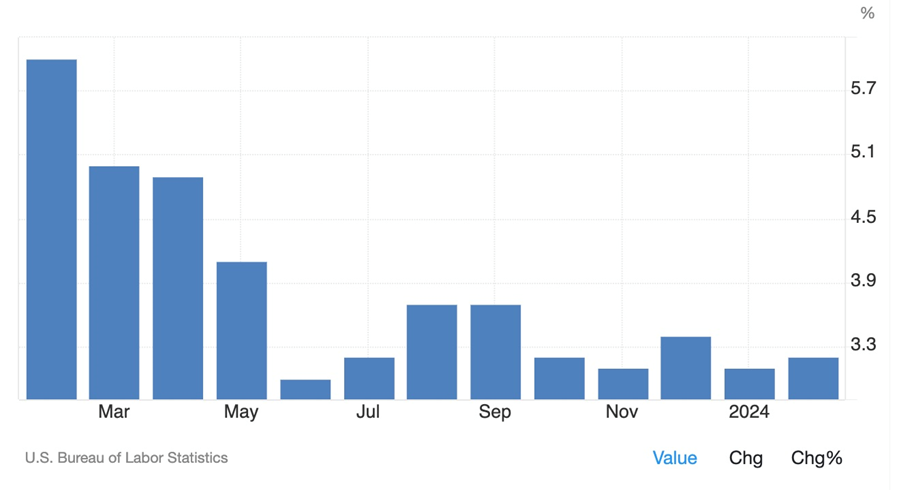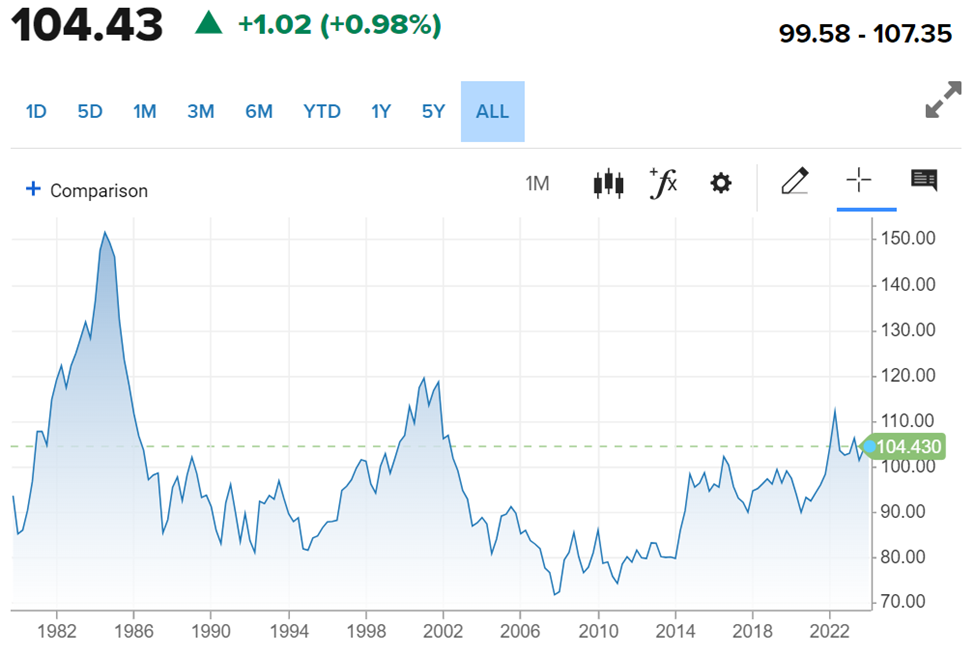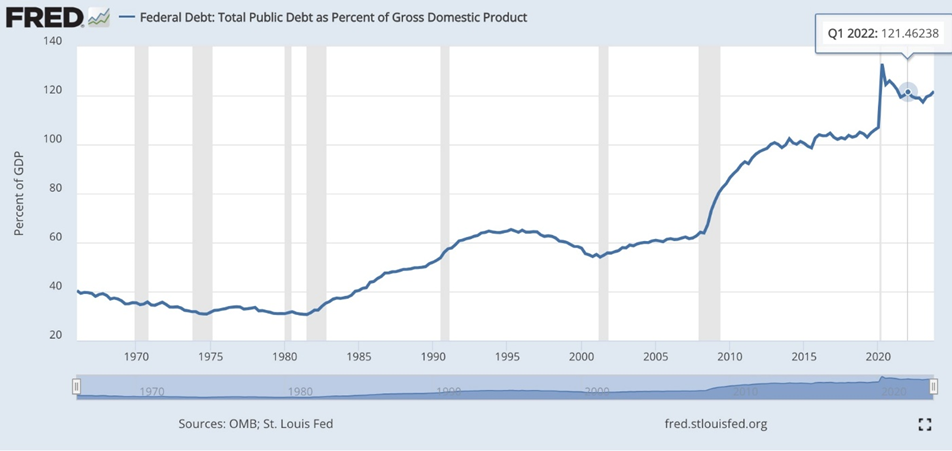Gold hit a record-high $2,200 an ounce Thursday, on expectations of interest rate cuts later this year.
 Source: Goldprice.org
Source: Goldprice.org
At its March meeting, the US Federal Reserve held its federal funds rate at 5.25 to 5.5%, and indicated it would slash interest rates three times (0.25% x 3 = 0.75%) in 2024 despite elevated inflation.
On Wednesday, Fed Chair Jerome Powell said officials would like to see more evidence that prices are coming down, but “it’s still likely in most people’s view that we will achieve that confidence and there will be rate cuts,” he said.
Spot gold set a record $2,222.39 in the early hours of trading Thursday, before settling to $2,206.10 for a 10% gain. US gold futures soared 2.4% to $2,208.20.
Gold’s rally, which started in mid-February, is underpinned mostly by increased geopolitical risks and central bank buying.
Silver followed gold higher on Thursday, hitting a pinnacle of $25.74 in early-morning trading, but fell to $24.58 at time of writing. Still, gold’s sister metal is up 11% since Feb. 13.
 Source: Silverprice.org
Source: Silverprice.org
The general consensus is that precious metals will continue to thrive over a longer horizon.
If the Fed follows through on its plan to lower rates thrice this year, it will cause the dollar to weaken and commodity prices to strengthen. When positive real interest rates, which favor bond investors, turn negative, it will especially affect gold and silver prices to the upside.
Citi’s North America head of commodities research says prices could hit $2,300 an ounce in H2 if the Fed cuts rates in the second half.
In our view, the case for gold revolves around three main factors: an increasingly dovish Fed monetary policy; unsustainably high debt, fueled by excessive government spending; and central bank buying.
Inflation trending down
Moderating inflation shows that the Fed’s monetary policy is restrictive enough to bring inflation to heel.
However, we are still at positive real rates of 1% (4.2% 10-year yield minus 3.2% CPI inflation), which for gold means further rate cuts are necessary before we are into a negative real rate environment favoring gold (and silver).
The market wanted to know how the Fed would respond to higher-than-expected inflation during the first two months of the year.
In a news conference Wednesday, Chairman Powell said the January (3.1%) and February (3.2%) data “haven’t really changed the overall story, which is that of inflation moving down gradually on a sometimes bumpy road towards 2%,” with rate cuts to follow.
Officials expect inflation to fall to 2.4% by the end of the year, approaching the Fed’s 2% target rate, the BBC reported. The economy should grow 2.1% this year, better than the 1.4% they projected in December.
 US inflation. Source: Trading Economics
US inflation. Source: Trading Economics
US dollar has peaked
The dollar is entering the end of its bull cycle after 13-plus years. A correction is long overdue, as USD’s spectacular performance in 2022 coincided with the Federal Reserve’s monetary tightening to curb inflation. Arguably, interest rates have peaked, and so has the dollar.
The US dollar index DXY hit 112 in June, 2022, an 11-year high. Since then, DXY has fallen 7.3%.

 US 10-year Treasury yield. Source: CNBC
US 10-year Treasury yield. Source: CNBC
Central bank buying
Central banks have bought historic levels of gold over the past two years, and continue to be strong buyers in 2024, the World Gold Council’s global head of central banks Shaokai Fan told CBNC.
China is the main driver of central bank demand, last year being the largest gold buyer. Chinese citizens also lead consumer purchases of physical gold — bullion for investment purposes and gold jewelry.
CNBC reports China’s weak economy and embattled real estate sector also drove more investors toward the safe-haven asset, with individual gold investment remaining robust, WGC said.
Many emerging-market economies are buying gold because they don’t want to be stuck in the same situation as Russia, which had about half of its foreign-currency reserves frozen following the 2022 invasion of Ukraine.
French bank Société Générale for the third consecutive quarter said it would maintain a 5% exposure to gold, despite reducing its overall commodity holdings by 1%.
Analysts said they are “keeping their gold investors warm,” Kitco wrote, as geopolitical tensions keep rising ahead of the US election in November.
Unsustainable debt
The US Treasury reported that, as of Dec. 29, 2023, total US debt surpassed $34 trillion for the first time. Compare this to January 2009, when the debt was just $10.6 trillion.
 Source: FRED
Source: FRED
The federal government keeps spending money and the Treasury keeps printing it, to cover the deficits which keep mounting.
The Biden administration’s three signature pieces of legislation — the Inflation Reduction Act, the Bipartisan Infrastructure Law and the CHIPS and Science Act — are costing trillions.
Around $13 trillion in government debt is expected to roll over next year, at much higher rates, meaning more money-printing is on the way.
In other words, the government can’t afford higher interest rates for much longer. Also it is an election year; consumer spending has to continue because consumers spending makes up 70% of the US economy. Consumers need debt payment relief to keep spending as wages and salaries soar.
Less gold being mined
We have previously written about the challenges facing world gold supply. The mining industry is currently unable to mine enough to meet annual demand, without recycling, which is our definition of peak gold.
Gold grades are declining and there have been very few major gold discoveries over the past several years.
The current US administration is anti-mining and has shut down a number of large mining projects. In the United States, a lot of gold mining takes place on land controlled by the Bureau of Land Management, or BLM. However, recent moves by the Biden administration suggest the White House is taking aim at precious metals production and might even cut off the supply of PMs from BLM land. This is happening in two ways.
First, Biden is designating more federal land as national monuments — repeating a policy of the Obama administration, which created 26 new national monuments covering over 88 million acres, and extended the boundaries of existing monuments to cover hundreds of million more acres.
Second is the proposed “Public Lands Rule”. While the rule in the BLM’s own words is “to ensure the health, diversity, and productivity of public lands for the use and enjoyment of present and future generations,” in practice this means the BLM would shift from trying to balance different uses of its land, such as hiking, hunting, fishing and mining, to putting environmentalists’ concerns first.
The gold market needs more gold mines to avoid having to recycle gold to meet global demand, but if Biden gets re-elected, federal opposition to US gold production is likely to intensify.
Gold-silver ratio
We’ve outlined the bullish case for gold, but what about silver? The lustrous metal is coveted for both investment purposes — like gold it is a safe haven against monetary debasement and geopolitical turbulence — but unlike gold, it has a multitude of industrial applications.
This includes solar power, the automotive industry, brazing and soldering, 5G, and printed and flexible electronics.
The Silver Institute forecasts a 140Moz silver deficit this year, the third consecutive annual shortfall, against robust silver industrial demand, which is expected to grow 8% to a record 632Moz.
Silver investors have been disappointed with silver’s performance of late, the metal being range-bound at around $23-24 an ounce. It certainly hasn’t been tracking gold’s rally.
However, according to Sprott Money, a breakout is coming, simply because silver cannot continue to be so undervalued compared to gold. Using a median gold-silver ratio of 80:1 (80 ounces of silver to buy one ounce of gold), a gold price of $2,300 implies a silver price of $28.75. If gold reaches $2,500, maintaining that same ration means $31.25 silver.
But the thing is, when silver breaks out later this year or next, it will receive the same rush of attention and speculator cash that gold is currently enjoying. As such, the price target will not simply be $29 or $31. Instead, the initial goal will be $35 or higher. That’s a greater than 50% move from here and one from which you could greatly profit if you get correctly positioned before it begins.
Remember, when precious metals rallied in 2020, on the back of lockdowns, interest rates slashed to zero, QE, and general market fear, silver’s gain was double that of gold. The price ran up 43% from January to December, 2020, compared to gold’s mere 20.8% rise. Earlier in the year, as gold punched above $2,000 an ounce, a 39% gain, silver rallied to nearly $30 an ounce, a 147% increase.
 Source: Kitco
Source: Kitco
Meanwhile, the silver-gold ratio fell from over 100:1 to just over 64:1. It could easily happen again.
Conclusion
At AOTH, we see strong upside for gold and silver in 2024.
We need to wait a few more months before the Fed is certain that its tight monetary policy has worked and that inflation is licked.
If and when, likely in June, the Fed starts to cut rates, the dollar will weaken, causing commodity prices (and precious metals) across the board to rise.


